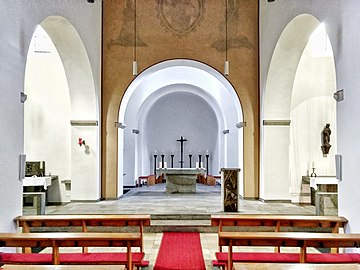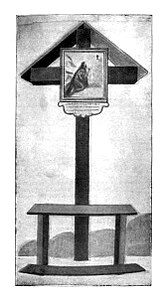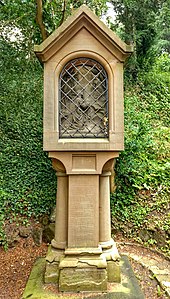Salvatorkirche (Aachen)
The Salvator Church on the Salvatorberg in Aachen is a church building of the Roman Catholic Church . It was completed in 1886. Previous buildings were first mentioned around 840 and consecrated to Jesus Christ in his capacity as Salvator Mundi ( Latin savior of the world ) no later than 870 .
From 997, the church was spatially connected to a monastery wing, in which Benedictines and Cistercians were first one after the other until around 1220 and then, after more than 700 years of vacancy, the oblates of the immaculate Virgin Mary served from 1949 to 2012 . The city of Aachen is currently the actual owner of the monastery and the attached church and has concluded a usage agreement for this facility with the Aachen Christian Social Welfare Service . The new church from the 19th century is a listed building .
The elevation on the outskirts of Aachen and on the southeastern foothills of the Lousberg got its name from the church.
Salvator Church
The monastery church on the Salvatorberg emerged from an earlier cemetery chapel , which Ludwig the Pious had built there around 840. Just 30 years later, it was described as "dilapidated" by his son Ludwig the German . According to a document dated October 17, 870, in which the chapel is officially referred to as St. Salvator's Chapel for the first time , the latter then placed it under the care of the Prüm Abbey . The incumbent abbot Ansbald von Prüm had the chapel restored and rededicated. In 997, Emperor Otto III bequeathed it . the Benedictine Monastery newly established on the Salvator mountain chapel as a gift, but already in 1005, the year of the inauguration of St. Adalbert , she explained his successor, Emperor Henry II. , the property of the Collegiate of St. Adalbert. Around 1039 followed on behalf of Emperor Heinrich III. In place of the old chapel, the new building of a flat-roofed three-aisled pillar basilica , which his still underage son Heinrich IV transferred to the Aachen Minster Monastery in 1059 with the approval of his mother, the incumbent regent Agnes von Poitou . The St. Salvator Chapel remained there until secularization in 1802.
Initially, the chapel on the Salvatorberg had gained an important reputation as a pilgrimage church , which among other things also led to the construction of the Aachener Neutor around 1175. Later, the chapel is only rarely mentioned in the sources, for example on June 5, 1459, when the vacant Andreas altar was given to the canon of the Aachen Minster Foundation, Peter of Cologne, and in 1612, when Leopardus was no longer needed -Altar also came into possession of the pen. In a letter of April 21, 1672, the Canon of St. Adalbert asked for permission to set up seven simple prayer stations along with wooden crosses on the way to the Salvator Church with his own financial means. This request was granted, but the stations were not regularly maintained and fell into disrepair over the course of the following decades. St. Salvator was also mentioned on the occasion of a visit in 1691, during which, among other things, considerable structural defects were pointed out. After the chapel continued to deteriorate over the next few decades, restorations and renovations took place between 1750 and 1800 , but further deterioration could not be stopped in the long term.
After the secularization, the Aachen Bishop Marc-Antoine Berdolet received the Salvatorkirche by decree of July 12, 1806 , who then donated a large part of the facility, including two bells, to the former Augustinian monastery in Pontstrasse , where the Royal High School in Aachen at that time was located was housed. The building of the church itself and the associated outbuildings as well as the apartments of the rector and the tenant and the attached lands were transferred by the bishop to the Josephine Institute, an institution for the poor and sick in Aachen. This set up the church again makeshift and used it for their devotional purposes. In the years that followed, however, the decay of the old church continued and it became apparent that a new building was required.
Finally, in 1883 , the Aachen city architect Joseph Laurent was commissioned to reconstruct the medieval church. Due to the existing inadequate building fabric, a new building in the form of a three-aisled basilica in the neo-Romanesque style was built by 1886 . The seven stations of the cross were also renewed at the expense of the association for the interior furnishings of the Salvatorkirche , this time made of stone and made in Wilhelm Pohl's sculpture workshop . The church was badly damaged in the Second World War and then rebuilt in the old style in 1949 on behalf of the Oblates of the Immaculate Virgin Mary according to plans by Wilhelm K. Fischer . The windows were designed in 1951 by Anton Wendling as a semicircle ornament and made from antique glass and lead and installed. In 1954 a small Fátima chapel was set up in the lower right aisle and in 1957 the choir and the altars were redesigned according to plans by Peter Salm . In 1964 the church received new windows based on a design by Ingeborg Hintzen, made in the Linnich glass painting company Oidtmann . In 1966 the chancel was redesigned and individual areas of the church were artistically painted by the Aachen painter Peter Hodiamont . In addition, even a portrait of Catholic saints was in the entrance area to the left Eugene de Mazenod attached, the Mission Congregation of the Oblates brought into being.
Finally, on April 17, 1966, St. Salvator was consecrated by the Aachen bishop Johannes Pohlschneider . After the closure of the attached monastery, the church, together with the Salvator Monastery, is again owned by the city of Aachen.
One of the special treasures of the Salvator Church is a bell from 1457, the statue of the Virgin Mary "Mater salvatoris", made around the end of the 15th century, the Fátima Madonna by Schollmayer from Düsseldorf from 1953, the Way of the Cross from the house of Michael P. Weingärtner, Pfaffenhofen, from 1957 and cross, candlestick and tabernacle by Wilhelm Winkelmann from 1962.
Salvator Monastery
In 997, the wealthy widow Alda founded a monastery community for freeborn virgins who oriented their lives according to the rules of St. Benedict of Nursia . Emperor Otto III. confirmed this foundation and allowed the new order to build its monastery building north of the existing Salvator Chapel. In addition, he transferred the chapel belonging to the Prüm Abbey and five more profitable estates to the order. The nuns consecrated the monastery complex both to the Savior (see salvatori) and to St. Corona . Although in the following years the chapel itself had to record several changes of ownership caused by the reigning rulers, the nuns were able to hold their prayer hours in the nuns' choir, which was added to the north. Finally, in 1147, the Cistercian women received the monastery building, but moved to Burtscheid as early as 1220 , where they took over the Burtscheid Imperial Abbey . A religious order for the successor was not found, also because it became known that the climate on the then barren hill was cold, damp and drafty and the nuns often complained of lung and bronchial diseases. During the siege of Aachen , Peter Cappuccio, the cardinal of Count Wilhelm von Holland , took possession of the monastery building and resided from there. After Wilhelm's coronation as the antagonist on November 1, 1248, he transferred the monastery grounds back to the Münsterstift and confirmed the earlier promises of donation. In the following centuries the monastery building on the Salvatorberg stood empty and was left to decay. The nuns' choir of the monastery church, which was no longer needed, was then converted into a sacristy .
It was not until around 700 years later that the Order of the Oblates of the Immaculate Virgin Mary, who had also been represented in Aachen since the Prussian era, took over the monastery complex and in 1949 left the heavily damaged St. Salvator Chapel and a year later the dilapidated monastery building according to plans by Wilhelm K. Fischer rebuild again. On February 8, 1951, the Oblates were able to move from their previous headquarters in Aachener Vaalser Straße to the new monastery on the Salvatorberg.
In November 2010, plans to sell the monastery finally became known, and the branch was given up on December 31, 2012 by the last three brothers of the Oblate Order of the Immaculate Virgin Mary and handed over to the Aachen Christian Social Welfare Service.
The Salvatorkirche had been completely restored by 2018. The costs for the interior renovation amounted to around 220,000 euros, of which 60,000 euros were taken over by the German Foundation for Monument Protection (DSD).
literature
- Christian Quix : The Royal Chapel and the former. noble nunnery on the Salvators-Berge, along with notes about the former vineyards near the city of Aachen . Urlichs, Aachen 1829 ( MDZ Munich [accessed on August 9, 2015]).
- Carl Rhoen : The St. Salvatorkapelle near Aachen. In: Journal of the Aachen History Association (ZAachenerGV). No. 6, 1884, pp. 65-80 ( Textarchiv - Internet Archive ).
- Eduard Teichmann: On the history of the name of the Aachen St. Salvatorkapelle. In: ZAachenerGV. No. 21, 1899, pp. 60–87 ( Textarchiv - Internet Archive ), No. 22, 1900, pp. 347–348 ( Textarchiv - Internet Archive ), No. 26, 1904, pp. 389–390 ( Textarchiv - Internet Archive ) and No. 28, 1906, pp. 464-465 ( Textarchiv - Internet Archive ).
- Eduard Teichmann: On the building history of the St. Salvator Chapel in the 18th century. In: ZAachenerGV. No. 29, 1907, pp. 327-333 ( Textarchiv - Internet Archive ).
- Eduard Teichmann: On the history of the stations on the Salvatorberg. In: ZAachenerGV. No. 29, 1907, pp. 334-337 ( Textarchiv - Internet Archive ).
- Joseph Frielingsdorf: The origin of the nunnery on the Salvatorberge near Aachen. In: ZAachenerGV. No. 43, 1921, pp. 228-265 Internet Archive .
Web links
- Entry on the former women's monastery Sankt Salvator (Lousberg, Salvatorberg) in the database " KuLaDig " of the Rhineland Regional Association
Individual evidence
- ^ Hugo Loersch : A document from 1459 concerning the Salvator Chapel . In: Journal of the Aachen History Association . 5th volume. Aachen 1883, p. 142–143 ( Text Archive - Internet Archive [accessed August 21, 2015]).
- ^ Foundation Research Center for Glass Painting of the 20th Century e. V., Aachen, Kath. Kirche St. Salvator , accessed on September 1, 2015.
- ^ Alfred Stoffels: Salvatorberg: The monastery is being sold. In: Aachener Nachrichten . Edition of November 9, 2010.
- ↑ The monastery on the Salvatorberg closes. In: Aachener Nachrichten. Edition of December 2, 2012.
- ^ Aachener Zeitung: Aachen: The Salvatorkirche shines again after restoration. Retrieved January 22, 2019 .
Coordinates: 50 ° 47 ' N , 6 ° 5' E







